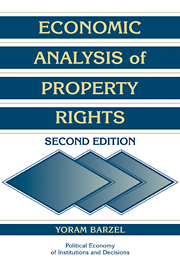Book contents
- Frontmatter
- Contents
- Series editors' preface
- Preface to the second edition
- Preface to the first edition
- Introduction
- 1 The property rights model
- 2 The public domain: Rationing by waiting and price controls
- 3 Contract choice: The tenancy contract
- 4 Divided ownership
- 5 The old firm and the new organization
- 6 The formation of rights
- 7 Slavery
- 8 Wealth-maximizing constraints on property rights
- 9 Property rights and non-market allocation
- 10 Additional property rights applications
- 11 The property rights model: Recapitulation
- References
- Index
9 - Property rights and non-market allocation
Published online by Cambridge University Press: 05 June 2012
- Frontmatter
- Contents
- Series editors' preface
- Preface to the second edition
- Preface to the first edition
- Introduction
- 1 The property rights model
- 2 The public domain: Rationing by waiting and price controls
- 3 Contract choice: The tenancy contract
- 4 Divided ownership
- 5 The old firm and the new organization
- 6 The formation of rights
- 7 Slavery
- 8 Wealth-maximizing constraints on property rights
- 9 Property rights and non-market allocation
- 10 Additional property rights applications
- 11 The property rights model: Recapitulation
- References
- Index
Summary
The property rights approach to the study of economics has been promoted by market-oriented economists, who have used it occasionally to demonstrate the superiority of the market. Contrary to the perception that property rights tools may best be used to analyze the market economy, where allocation is performed largely if not entirely by prices, these tools seem to be uniquely well suited to analyzing resource allocation in non-market settings. Under the Walrasian approach, where rights are perfectly defined, nothing is lost by quickly dispensing with the topic of property rights, for there is little to say about them within that model, where prices determine everything. Indeed, the Walrasian model may provide satisfactory answers to many problems in capitalist economies, where prices play a vital role in economic life.
Those economists who have contributed most to the study of property rights tend to be strong advocates of unregulated markets. They contend that people and the economy thrive when left to their own devices, and that government intervention tends to reduce wealth. In the market, the argument goes, prices move resources to their highest-value uses; when prices are not given the opportunity to perform their function, misallocation results. Government intervention is deemed acceptable in such areas as national defense, police, the courts, and the money supply; such intervention is said to be desirable only inasmuch as it facilitates the functioning of markets. Despite the prevalence of this reasoning, government regulations cannot be dismissed on a priori grounds.
- Type
- Chapter
- Information
- Economic Analysis of Property Rights , pp. 128 - 138Publisher: Cambridge University PressPrint publication year: 1997



